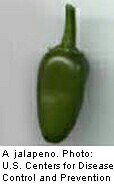 |
 |
 |

FDA Clears U.S. Hot Peppers in Salmonella Outbreak
Tainted jalapeno sample traced back to Mexican farm, agency announces|
|
HealthDay
Friday, July 25, 2008
 FRIDAY, July 25 (HealthDay News) -- Almost a week after uncovering the first big clue in the nationwide salmonella outbreak, U.S. health officials announced Friday that tainted jalapeno peppers had been definitively traced to a farm in Mexico.
FRIDAY, July 25 (HealthDay News) -- Almost a week after uncovering the first big clue in the nationwide salmonella outbreak, U.S. health officials announced Friday that tainted jalapeno peppers had been definitively traced to a farm in Mexico.
The U.S. Food and Drug Administration gave the all-clear to jalapeno and serrano peppers grown in the United States, but warned consumers to avoid any raw jalapenos or serranos grown in Mexico or the foods made from them.
The FDA added, in a late-day advisory, "In addition to domestically grown raw jalapeo peppers, commercially canned, pickled and cooked jalapeo peppers from any and all geographic locations also are not connected with the current Salmonella saintpaul outbreak."
And it said, the FDA was "working with state regulatory agencies and food industry groups that represent restaurants, grocery chains and wholesalers to ensure everyone clearly understands this new, more narrow, advisory."
A sample of a Mexican-grown jalapeno tainted with Salmonella saintpaul was found at a packing plant in Mcallen, Texas, Dr. David Acheson, the FDA's associate commissioner for foods, had announced at a teleconference Monday.
It was the first break in a months-long search for the produce that produced bacteria that so far has sickened 1,294 people in the United States and Canada. And it turned the consumer eye away from raw tomatoes, which had been suspected as the source since the outbreak started in April.
"While this one sample doesn't give us the whole story, this genetic match is a very important break in the case," Acheson said on Monday. "This will ultimately, hopefully, allow us to pinpoint the source of the contamination, which has caused the outbreak."
On Friday, Acheson told the AP, "Domestically grown products are not tracing back at all to the outbreak. On Monday, we didn't know exactly where they all were coming from. Today, we're certain these are coming from Mexico."
In its announcement Friday, the agency explained: "The collective review of the current traceback investigation and harvesting dates, matched with the dates that people became ill, have combined to indicate that the contaminated jalapeo pepper originated in Mexico."
It added, "Additional traceback and traceforward information obtained this week has led to the determination that the Agricola Zarigosa produce-distribution center in McAllen, Texas -- from where FDA took the positive jalapeo pepper sample -- was not the original source of the contamination."
Acheson said that FDA inspectors were on site at the Mexican farm where the tainted pepper came from.
Raw jalapeno peppers are often used in the preparation of salsa, pico de gallo and other dishes.
When the outbreak began in April, early signs pointed to raw tomatoes -- particularly raw round, red tomatoes, plum or Roma tomatoes -- as the likely source of contamination. But the FDA lifted its warning on tomatoes last week because it was highly unlikely that any tomatoes that were on the market at the start of the outbreak remain on the market.
According to the CDC, people stricken during the outbreak have ranged in age from under 1 to 99 years old, and 50 percent are female. The rate of illness has been highest among those 20 to 29 years old; it is lowest among adolescents 10 to 19 years old and people over 80.
According to the CDC's latest count as of July 25, the breakdown by state of ill people shows: Alabama (3), Arkansas (19), Arizona (56), California (9), Colorado (16), Connecticut (5), Florida (3), Georgia (40), Idaho (6), Illinois (115), Indiana (20), Iowa (2), Kansas (20), Kentucky (2), Louisiana (2), Maine (1), Maryland (37), Massachusetts (29), Michigan (25), Minnesota (22), Mississippi (2), Missouri (20), Montana (1), New Hampshire (5), Nevada (13), New Jersey (14), New Mexico (106), New York (39), North Carolina (23), Ohio (10), Oklahoma (25), Oregon (11), Pennsylvania (12), Rhode Island (3), South Carolina (2), Tennessee (9), Texas (495), Utah (2), Virginia (31), Vermont (2), Washington (17), West Virginia (1), Wisconsin (13), and the District of Columbia (1). Five ill persons are from Canada; four appear to have been infected while traveling in the United States, and one individual remains under investigation.
Salmonella is a bacteria that can cause bloody diarrhea in humans. Some 40,000 cases of salmonellosis are reported in the United States each year, although the CDC estimates that because milder cases aren't diagnosed or reported, the actual number of infections may be 30 or more times greater. Approximately 600 people die each year after being infected.
However, the strain of Salmonella saintpaul had been previously considered rare. In 2007, according to the CDC, there were only six people infected in the country during April through June.
HealthDay
Copyright (c) 2008 ScoutNews, LLC. All rights reserved.
Related News:
- More News on Food Contamination and Poisoning
- More News on Food Safety
- More News on Salmonella Infections
More News on this Date
Related MedlinePlus Pages:
| Home | Health Topics | Drugs & Supplements | Encyclopedia | Dictionary | News | Directories | Other Resources | |
| Disclaimers | Copyright | Privacy | Accessibility | Quality Guidelines U.S. National Library of Medicine, 8600 Rockville Pike, Bethesda, MD 20894 National Institutes of Health | Department of Health & Human Services |
Date last updated: 28 July 2008 |




